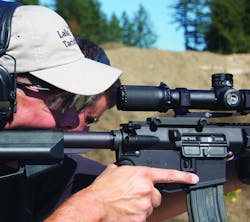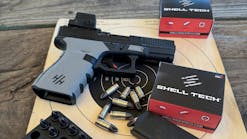Putting the ‘tact’ in tactical optics
I believe I have the best job in the world. I get to meet really interesting people, shoot all the new products and write about my experiences. This October, I visited the folks at Leupold in Beaverton, Ore. My visit included a factory tour and a little range time with the latest products.
Leupold: What is right about America
The company who employs over 600 people in the Beaverton area is fifth generation, family owned. Leupold & Stevens is a 103-year-old American success story. My last factory tour was during its 100th anniversary, and I commented at the time that it was appropriate Leupold supplies products for the United States Armed Forces, including its partnership with Knight's Armaments, Remington Arms and Barrett Firearms -- three other companies that emulate what is right with America.
Leupold is unique in many ways. First, it don't just build scopes; it designs and builds the tool packages for the machining process. Leupold also uses proprietary lubes and adhesives in its products. Second, the work is done at the factory, not farmed out somewhere else. Perhaps the part that surprises sporting optics experts most is the fact that Redfield scopes are made on the same factory floor, using the same lathes and tooling. This makes Redfield riflescopes the greatest bargain in the industry, because they are sold at an entry-level price point with the same high manufacturing standards. Third, the company makes its scope bases on the same property, including the Mark 4 bases of 8028 steel. Last, Leupold seriously abuses its (and its competitors') products, using some of the highest standards in the industry. Most scope manufacturers use a drop test or the equivalent to measure durability. Leupold shoots the cartridge intended for the scope/rifle combination, and uses the algorithm from the recoil and duplicates the energy in its impact room.
Collecting tactical feedback
During the tour Leupold introduced its new dedicated Tactical Optics Division. Although the company has always made excellent tactical scopes and optics, the new division will allocate engineering resources toward the end user. Along with its sporting line, there are plenty of resident resources, owing to the excellent hunting conditions and knowledgeable hunters on staff. Getting quantifiable feedback from tactical end-users is a little more elusive. Leupold's approach with tactical optics will include getting the engineering team to the end-users in order to produce "battlefield upgrades." This means that engineers will travel a lot and translate the language of American heroes into products that make their jobs easier.
Commendable upgrades
I got to see one of these battlefield upgrades firsthand. First, Leupold has partnered with Horus on quite a few products. Horus has several reticle styles that have adjustment grids on their bottom half. To a hunter, this reticle style may be confusing. But to a precision shooter, it allows for snap engagement adjustments based on the input from the spotter, passive ranging and fast follow-up shots.
The Horus reticle is the quickest way to adjust for wind value without turning the turrets. It is really handy past 100 yards when the shooter is in place with a full value wind (perpendicular to the barrel) and has to take a shot at the 3 (or 9) o'clock, which will reduce the effect to half value. Rather than turn the turrets, the shooter uses the grid.
The other upgrade was a "Why didn't I think of that?" for me. The new Leupold Mark 4 ER/T scope has 1/10 mil adjustments. This means that the language between the precision shooter and spotter is the same, reducing the lag time in calculation.
Why didn't I think of that?
Not a common scope
The new MARK 8 ER/T (Extreme Range/Tactical) that I took for a spin is a 6.5-20x50. It also comes in 8.5-20x50. There are two reticle choices: a Horus H-27 or H-58. The Mark 8 ER/T 6.5-20x50 has a 34mm main tube. Yes, 34mm. This is a scope designed for extreme ranges; a 34mm main tube gives it extended elevation. It also has auto locking turrets. I got to run rounds downrange with the Mark 8 ER/T mounted on a Remington Modular Sniper Rifle, which comes in .338 Lapua Mag, 300 Win Mag or 7.62 NATO.
The MSR has an adjustable folding stock, which begs the question: How does Remington squeeze such precision out of a platform with so much adjustability? I got to run the .338 Lapua Mag version, which uses a Trynite coating in its components. I'm not sure what Trynite is, but it had an extremely smooth lockup and a better trigger than one of my match rifles.
The MSR is designed to engage up to a click and a half. If you aren't familiar with a click, ask your military buddies. This is not a common product and the Mark 8 ER/T is not a common scope. The most notable features of the Leupold Mark 8 ER/T 6.5-20x50mm scope are the auto locking turrets, which allow for adjustments on the fly and exceptional coatings. Coatings, by the way, are what one pays for in a scope. The Extended Twilight Lens System coatings on this product add to the crispness of the image during twilight or dusk.
Ideal for high-risk stops
The engineering it takes to make a 1.1-power scope go seamlessly to 8-power without serious distortion is astronomical. This scope has interchangeable BDC rings, which allow the user to switch bullet weights for a specific mission. I had a chance to peek at this one with a thermal sight in front of it.
The Mark 4 CQBSS comes with a Horus H27 reticle and allows for snap engagements and ranges that would be considered extreme for an AR 15 variant. The 34mm maintube allows for a wide range of adjustment.
I shouldered the Remington carbine that this scope was mounted on. The scope has aggressive knurls for rapid adjustment, as well as a .10 mil pinch and turn adjustments. I rocked the magnification from 1.1-8. Then it hit me: This is a front focal plane instrument, meaning the reticle always stays in proportion to the magnification. The Leupold Mark 8 CQBSS floats a 5 MOA dot on the target, when illuminated.
Where would the Mark 8 CQBSS excel? On a high-risk stop where the threat is perceived, but not fully known. The responding officer can engage at the compressed distance of the driver door/ patrol car door with a mid magnification, and scan for additional threats at 1.1. If the incident develops into a longer engagement, the scope is appropriate. If the stop at dusk goes to darkness, the officer doesn't need to change anything.
I cranked the power down and double-tapped steel with this one. I cranked it up and looked at my hits on paper. This scope has exceptional clarity.
Putting rounds downrange
Obviously, the best part of participating in a product introduction is the opportunity to put rounds downrange with these new products. I was feeling pretty good about the 1x8 scope mounted on an AR-15 variant.
On a range near Beaverton, we warmed up a bit with steel plates at 25 yards. I began by experimenting with the CMR reticle on the new Mark 4 HAMR. This is a 4-power rugged scope with a Leupold Delta Point optic mounted on top. It took a few minutes to get the cadence of switching between the Delta Point and the HAMR optic, but the CMR2 reticle was incredibly easy to center for a snap shot.
We began running through a move-and-shoot stage, which looked like the carbine-friendly part of a three-gun match.
Remington provided the carbine here and this was also my first chance to run rounds downrange with the ACR (Adaptive Combat Rifle) -- a modular combat system that is fully ambidextrous with a piston driven action and equipped with an AAC suppressor. With the HAMR mounted, I found the Remington ACR was ergonomic and felt more natural than several carbines I tested this past year. This one was 5.56 Remington, but a quick bolt head change makes the ACR a 6.8 Remington.
I was feeling pretty good on my first run with the HAMR equipped Remington ACR. I shouldered it and moved smartly down the course, double tapping each target. I was rewarded with the staccato sound of jackets on steel at the end of the stage. Good hits. Superior glass.
The HAMR has an exit pupil of 6, a quick calculation of the potential brightness of an optic based on the quick calculation of the size of the objective divided by the magnification. Coatings and quality of construction complete the package. I will spend a little more time with this product next year, but the night fighting potential of this product is self evident.
The CMR reticle gives the shooter just enough center dot to pick it up on the fly without covering up too much target. The etched reticle (which is LED illuminated) has stadia lines that aid in bullet drop compensation for AR-15 variants.
It's true, I was feeling pretty good about my shooting; right up until the shooter who followed ran the course ... literally. He picked up the HAMR/ACR tool and neutralized threats at a dead run. Having trained military shooters for years, I've always had great respect for shooters that are USMC trained. This Marine renewed my respect. OK, I still felt good about my shooting -- I just felt better about his.
I really have the best job in the world. Often, the products I get to see make me proud enough to share them. These products are ready to be sworn in.
Lindsey Bertomen is a retired police officer who teaches at Hartnell College in Salinas, Calif.

Officer Lindsey Bertomen (ret.), Contributing Editor
Lindsey Bertomen is a retired police officer and retired military small arms trainer. He teaches criminal justice at Hartnell College in Salinas, California, where serves as a POST administrator and firearms instructor. He also teaches civilian firearms classes, enjoys fly fishing, martial arts, and mountain biking. His articles have appeared in print and online for over two decades.



